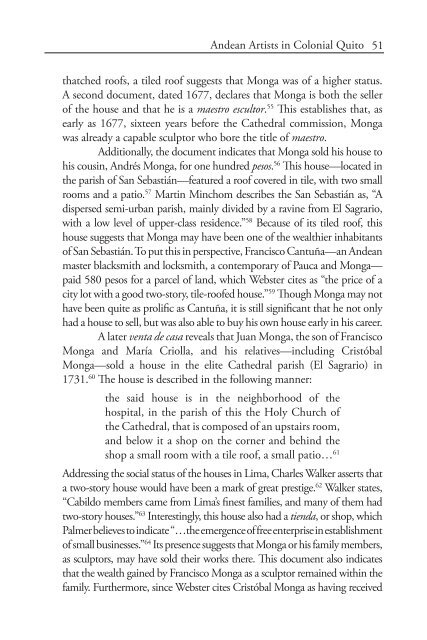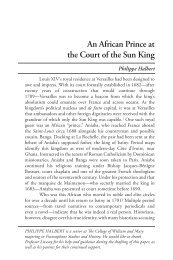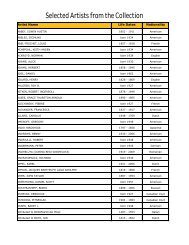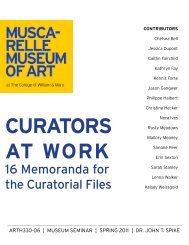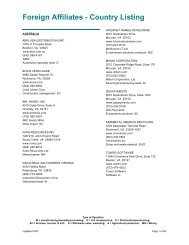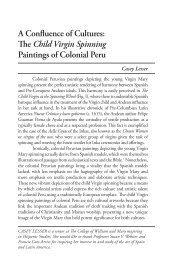Andean Artists in Colonial Quito: - College of William and Mary
Andean Artists in Colonial Quito: - College of William and Mary
Andean Artists in Colonial Quito: - College of William and Mary
You also want an ePaper? Increase the reach of your titles
YUMPU automatically turns print PDFs into web optimized ePapers that Google loves.
<strong>Andean</strong> <strong>Artists</strong> <strong>in</strong> <strong>Colonial</strong> <strong>Quito</strong><br />
thatched ro<strong>of</strong>s, a tiled ro<strong>of</strong> suggests that Monga was <strong>of</strong> a higher status.<br />
A second document, dated 1677, declares that Monga is both the seller<br />
<strong>of</strong> the house <strong>and</strong> that he is a maestro escultor. 55 This establishes that, as<br />
early as 1677, sixteen years before the Cathedral commission, Monga<br />
was already a capable sculptor who bore the title <strong>of</strong> maestro.<br />
Additionally, the document <strong>in</strong>dicates that Monga sold his house to<br />
his cous<strong>in</strong>, Andrés Monga, for one hundred pesos. 56 This house—located <strong>in</strong><br />
the parish <strong>of</strong> San Sebastián—featured a ro<strong>of</strong> covered <strong>in</strong> tile, with two small<br />
rooms <strong>and</strong> a patio. 57 Mart<strong>in</strong> M<strong>in</strong>chom describes the San Sebastián as, “A<br />
dispersed semi-urban parish, ma<strong>in</strong>ly divided by a rav<strong>in</strong>e from El Sagrario,<br />
with a low level <strong>of</strong> upper-class residence.” 58 Because <strong>of</strong> its tiled ro<strong>of</strong>, this<br />
house suggests that Monga may have been one <strong>of</strong> the wealthier <strong>in</strong>habitants<br />
<strong>of</strong> San Sebastián. To put this <strong>in</strong> perspective, Francisco Cantuña—an <strong>Andean</strong><br />
master blacksmith <strong>and</strong> locksmith, a contemporary <strong>of</strong> Pauca <strong>and</strong> Monga—<br />
paid 580 pesos for a parcel <strong>of</strong> l<strong>and</strong>, which Webster cites as “the price <strong>of</strong> a<br />
city lot with a good two-story, tile-ro<strong>of</strong>ed house.” 59 Though Monga may not<br />
have been quite as prolific as Cantuña, it is still significant that he not only<br />
had a house to sell, but was also able to buy his own house early <strong>in</strong> his career.<br />
A later venta de casa reveals that Juan Monga, the son <strong>of</strong> Francisco<br />
Monga <strong>and</strong> María Criolla, <strong>and</strong> his relatives—<strong>in</strong>clud<strong>in</strong>g Cristóbal<br />
Monga—sold a house <strong>in</strong> the elite Cathedral parish (El Sagrario) <strong>in</strong><br />
1731. 60 The house is described <strong>in</strong> the follow<strong>in</strong>g manner:<br />
the said house is <strong>in</strong> the neighborhood <strong>of</strong> the<br />
hospital, <strong>in</strong> the parish <strong>of</strong> this the Holy Church <strong>of</strong><br />
the Cathedral, that is composed <strong>of</strong> an upstairs room,<br />
<strong>and</strong> below it a shop on the corner <strong>and</strong> beh<strong>in</strong>d the<br />
shop a small room with a tile ro<strong>of</strong>, a small patio… 61<br />
Address<strong>in</strong>g the social status <strong>of</strong> the houses <strong>in</strong> Lima, Charles Walker asserts that<br />
a two-story house would have been a mark <strong>of</strong> great prestige. 62 Walker states,<br />
“Cabildo members came from Lima’s f<strong>in</strong>est families, <strong>and</strong> many <strong>of</strong> them had<br />
two-story houses.” 63 Interest<strong>in</strong>gly, this house also had a tienda, or shop, which<br />
Palmer believes to <strong>in</strong>dicate “…the emergence <strong>of</strong> free enterprise <strong>in</strong> establishment<br />
<strong>of</strong> small bus<strong>in</strong>esses.” 64 Its presence suggests that Monga or his family members,<br />
as sculptors, may have sold their works there. This document also <strong>in</strong>dicates<br />
that the wealth ga<strong>in</strong>ed by Francisco Monga as a sculptor rema<strong>in</strong>ed with<strong>in</strong> the<br />
family. Furthermore, s<strong>in</strong>ce Webster cites Cristóbal Monga as hav<strong>in</strong>g received<br />
51


